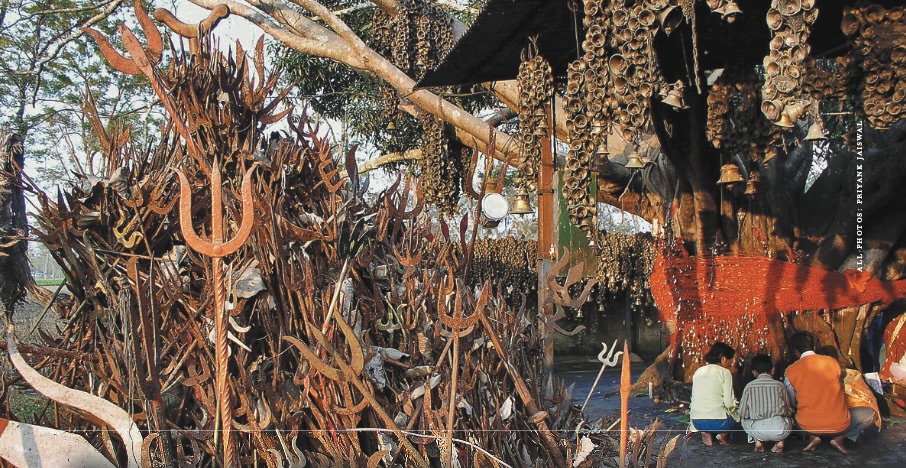BY PRIYANK JAISWAL
Traveling through assam close to Digboy, the oldest oil field of India, I came across a most unusual Siva temple called the Tillinga Mandir. Actually, it isn’t a temple at all. It’s a tree–a pipal tree, ficus religiosa, to be exact–with tens of thousands of bells hanging on its branches. Tillinga means “bell ” in Assamese. Mandir means “temple.”
This bell tree is as spiritually strong as any temple I’ve ever seen. Its power is almost palpable, as if a portion of each blessing Lord Siva gave to every devotee that worshiped there stayed back with the tree to help build its spiritual presence.
The bells are large, small, old, new, bronze, brass and copper. Never before have I seen such a vast and varied collection. There are also thousands of Siva tridents haphazardly speared deep into the sand here and there. Most of them are packed together in one place, madly jutting out of the ground about thirty feet away from the pipal tree.
According to Dhananjay Pande, the priest of the Tillinga Mandir, these tridents were left by ascetic devotees of Lord Siva who took rest under the tree while in route on pilgrimage. In the cool shade of its spreading branches, they felt a unique spiritual presence and left their tridents behind as a testament to this profound experience.
Long ago, one such ascetic unearthed a naturally formed, black rock Sivalingam, nestled among the roots of the tree. When news of this discovery got around, people started coming to worship. The fame of the bell tree temple with its mysterious Lingam exploded when pilgrims discovered that wishes they expressed in prayer under the tree actually came true.
In the beginning, devotees would express their gratitude by returning to hang a bell on the tree after their wishes had been fulfilled. Eventually, however, the custom changed and pilgrims began to bring bells as offerings even before they said their prayers and made their wishes.
“About 60 years ago on the advice of the village elders, ” explained the priest, “the owner of the land upon which the pipal tree is located officially designated the property as a temple and opened it to the public. Since then, thousands of devotees have come with hopes, prayers and bells.”
Today, despite its increasing fame, the Tillinga Mandir continues to be immersed in a unique mystical silence, broken only by the chanting of mantras, the fluttering of pigeons and the ringing of the bells.
The special places where India’s Gods choose to live reflect their power and serve as a focal point for their grace. No one who has visited the Tillinga Mandir would deny that Lord Siva has taken up residence there, and no serious pilgrim who has worshiped the Lingam at the base of its pipal tree could ignore His life-changing presence.
I will never forget this holy place where so many thousands of bells are tied to every reachable part of this lonely banyan tree shading a naturally formed Siva Lingam. Wherever I am, whatever I am doing, I can stop and listen within to hear those bells ringing silently with the joy of wishes fulfilled and the music of Siva dancing.”
